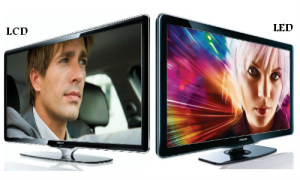
What’s the difference between LCD and LED?
LCD stands for “liquid crystal display” and technically, both LED and LCD TVs are liquid crystal displays. The basic technology is the same in that both television types have two layers of polarized glass through which the liquid crystals both block and pass light. So really, LED TVs are a subset of LCD TVs.  LED, which stands for “light emitting diodes,” differs from general LCD TVs in that LCDs use fluorescent lights while LEDs use those light emitting diodes. Also, the placement of the lights on an LED TV can differ. The fluorescent lights in an LCD TV are always behind the screen. On an LED TV, the light emitting diodes can be placed either behind the screen or around its edges. The difference in lights and in lighting placement has generally meant that LED TVs can be thinner than LCDs, although this is starting to change. It has also meant that LED TVs run with greater energy efficiency and can provide a clearer, better picture than the general LCD TVs. LED TVs provide a better picture for two basic reasons. First, LED TVs work with a color wheel or distinct RGB-colored lights (red, green, blue) to produce more realistic and sharper colors. Second, light emitting diodes can be dimmed. The dimming capability on the back lighting in an LED TV allows the picture to display with a truer black by darkening the lights and blocking more light from passing through the panel. This capability is not present on edge-lit LED TVs; however, edge-lit LED TVs can display a truer white than the fluorescent LED TVs. Because all these LCD TVs are thin-screen, each has particular angle-viewing and anti-glare issues. The backlit TVs provide better, cleaner angle viewing than the edge-lit LED TV. However, the backlit LED TV will usually have better angle viewing than the standard LCD TV. Both LED and LCD TVs have good reputations for their playback and gaming quality.
LED, which stands for “light emitting diodes,” differs from general LCD TVs in that LCDs use fluorescent lights while LEDs use those light emitting diodes. Also, the placement of the lights on an LED TV can differ. The fluorescent lights in an LCD TV are always behind the screen. On an LED TV, the light emitting diodes can be placed either behind the screen or around its edges. The difference in lights and in lighting placement has generally meant that LED TVs can be thinner than LCDs, although this is starting to change. It has also meant that LED TVs run with greater energy efficiency and can provide a clearer, better picture than the general LCD TVs. LED TVs provide a better picture for two basic reasons. First, LED TVs work with a color wheel or distinct RGB-colored lights (red, green, blue) to produce more realistic and sharper colors. Second, light emitting diodes can be dimmed. The dimming capability on the back lighting in an LED TV allows the picture to display with a truer black by darkening the lights and blocking more light from passing through the panel. This capability is not present on edge-lit LED TVs; however, edge-lit LED TVs can display a truer white than the fluorescent LED TVs. Because all these LCD TVs are thin-screen, each has particular angle-viewing and anti-glare issues. The backlit TVs provide better, cleaner angle viewing than the edge-lit LED TV. However, the backlit LED TV will usually have better angle viewing than the standard LCD TV. Both LED and LCD TVs have good reputations for their playback and gaming quality.
Recommended Questions
Recommended Files from Library
Useful Files
Users Joined












